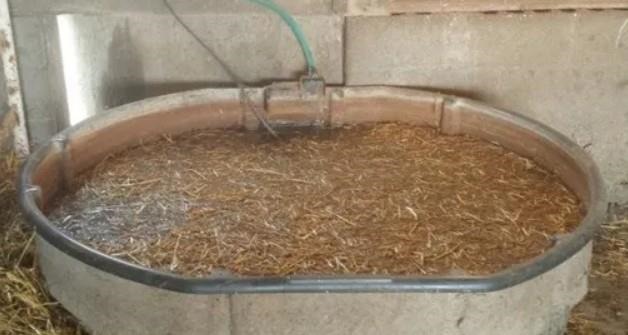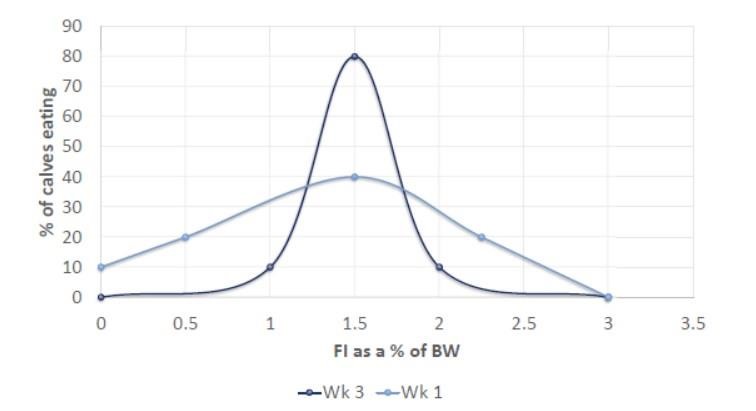By Tara L. Felix
First, feedlot transition should be defined. Feedlot transition refers to the first 21 to 28 days that new cattle arrive at a confinement facility. During this time frame, cattle are faced with many changes; therefore, transitioning newly weaned calves to the feedlot is a critical process. Several factors are associated with this transition and can impact the life of young animals if not carefully managed. Some of these factors include, but are not limited to environment and management, commingling, diet composition, new feed and water sources, vaccinations, and handling. The easier we make the feedlot transition for young calves, the better they will grow and perform throughout their time in the feedlot. Thus, the goal should always be to make this transition as easy as possible. There are a few fundamental principles in order to ensure success. In this brief overview of the transition period, some of the stress factors that can be mitigated will be discussed; but, emphasis will be placed on managing nutrition, as dictated by feed and water intake, as this is a fundamental stressor during the transition to the feedlot.
Many times, cattle arrive at the feedlot stressed, dehydrated, and weakened from hauling. The combination of exposure and dehydration decreases the calf's ability to fight pathogens and predisposes them to diseases. Bearing this in mind, management upon arrival is crucial to a successful transition. Cattle arriving at the feedlot should be granted rest once they are unloaded from the truck. Many professionals recommend a minimum of 24 hours of rest prior to processing (discussed below) cattle. During this rest period, cattle should be provided clean water and long stem hay. Keep in mind where cattle are coming from. For example, if they have only ever seen natural water sources, do not just assume they will drink out of a cup. Instead, provide a tank, perhaps with running water, as they enter the pen so that they can see and hear the water. These initial hours are key for the success of the transition.
During the transition period, and prior to even bringing in new cattle, work with your veterinarian to help overcome and prevent sickness. Having an established veterinary-client-patient-relationship (VCPR) will ensure that you have access to treatments incoming cattle may require. In addition, an area to receive sick and injured animals (or a hospital pen) should be established. Separating sick animals can help them recover from sickness, can make it easier for you or the vet to observe those animals, and may help prevent the spread of disease to other cattle in the feedlot. Hospital pens should be clean and comfortable and cattle housed there should be treated with as little disruption as possible for best results. Work closely with your veterinarian to establish an operating herd health protocol and specify procedures for receiving and transition within that protocol.
Part of that protocol should include processing procedures. Once cattle have arrived and are rested, they will need to be processed – vaccinated, implanted (if being done), and, preferably, weighed. Processing cattle is a standard practice on feedlot entry. During processing, cattle are often separated into homogeneous groups – similar weight, sex and ideally same origin. Keeping cattle of similar origins together can help reduce competition because the pecking order – or hierarchy - has already been established. Every time cattle are resorted or regrouped, this hierarchy is disrupted. Pens of cattle that are regrouped require about 20 days to reestablish their hierarchy because of their competitive behavior. During these 20 days, intake and feed efficiency will be depressed; therefore, resorting should be avoided, or at the very least minimized, whenever possible.
While establishing dominance among new pen mates, cattle are also adapting to the new environment, water troughs, and feed bunks. At least 1 linear inch of water tank access per head in the pen, or the ability of 10 percent of the cattle to drink at the same time, is recommended, particularly during the transition period. In addition to ample space, water quality is of the utmost importance to ensure adequate water intake. Water intake is the primary driver of dry matter intake; thus, clean water tanks that supply fresh water should be a priority. Water tanks should be checked daily and cleaned thoroughly at least once a week to avoid algae growth in excess or contamination from feed and manure. Contaminated water – like that shown in Figure 1 - will not be consumed, and this will decrease feed intake.

Figure 1. Contaminated or dirty water tanks will reduce dry matter, or feed, intake. Photo credit: Brian McAllister, used with permission.
Even though intake is critical to growth, cattle that are experiencing multiple stressors, like cattle transitioning to a feedlot, do not eat well. In fact, the intake pattern of cattle during the first week in the feedlot is usually erratic. Intake varies among cattle and throughout the first days, as shown in Figure 2. According to research, the "normal" feed intake for cattle will not resume until 21 days after feedlot entry. Thus, focusing on nutrition during these early days will play a very important role in the success of the feedlot. By the end of the 21 to 28-day transition period, feed intake should become more uniform and cattle will consume closer to the desired amount of feed.

Figure 2. Change in pattern of feed intake (FI as a % of body weight) by newly weaned calves transitioning to feedlot on weeks 1 and 3 after arrival. Figure courtesy of Dr. Tara Felix, Penn State Extension.
One of the challenges of erratic intake behavior is that it may lead to ruminal acidosis. Ruminal acidosis occurs when there is a more rapid production of acids in the rumen than the rumen wall, or epithelium, can absorb. The acid production drops ruminal pH and can cause ruminitis, or inflammation of the rumen epithelium. Ruminitis is thought to increase the passage of bacteria from the rumen into the bloodstream. Those bacteria can lodge in the liver and lungs, ultimately causing liver abscesses and pneumonia. Many times, feedlot operators do not realize acidosis has occurred; however, digestive disorders are the second most abundant cause of morbidity in confined cattle, behind only respiratory conditions. Any morbidity, or sickness, can reduce cattle growth throughout the entire feeding period. Thus, the goal during transition should always be to alleviate digestive upsets and to maintain digestive function.
One of the first nutritional challenges of the transition period is to adjust cattle, and the rumen, to a grain-based diet. Because it takes time for the rumen to adjust to dietary changes, it is necessary to adapt cattle to a high-grain diet by gradually increasing grain concentration in the diet and decreasing fiber content (Table 1). Many nutritionists recommend a 14 to 21-day transition to grain, depending on whether or not cattle have ever been fed grain. Weaned calves often come from pasture-based systems with little exposure to grain prior to feedlot entry, thus, a slow transition, similar to that in Table 1, over 21 days, is often recommended. Slower dietary transitions as cattle move from pasture to feedlots (grain diets) are crucial and can help reduce the number of digestive upsets encountered in the feedlot.
Table 1. Suggestion on how to slowly transition the diet from forage-based to grain-based.
| Pasture/
Hay on arrival | Step 1 | Step 2 | Step 3 | Feedlot Diet |
|---|
| Forage, % diet DM | 100 | 50 | 40 | 30 | 20 |
| Grain, % diet DM | 0 | 50 | 60 | 70 | 80 |
| Suggested days per step | - | 7 | 7 | 7 | - |
In addition to a slow transition to grain, controlling or managing intake, can help alleviate digestive upsets. Keep in mind that while animals are transitioning to grain, the energy density of the diet is increasing. Corn contains roughly twice as much energy as hay. Therefore, simply transitioning to grain is increasing the energy density of the diet and energy consumption of the animal. Cattle crave consistency. By limiting intake while grain is being introduced, the nutritional changes (intake and energy density) the calf is exposed to each day are limited.
While managing cattle intakes, it is important to remember that nutrition is more about consumption than concentration. While diets are often discussed on a percent crude protein (CP) basis, cattle require a certain amount – pounds or grams - of protein every day. Thus, when intakes are restricted, a greater protein concentration must be fed in the diet in order to meet the pounds per day requirements of the growing cattle (Table 2).
Table 2. Dietary protein needs of a 400-lb calf at different rates of body weight (BW) gain.1
| Gain lb/d | Protein,
% of diet DM |
|---|
| Calf eating 1% of BW | |
| 0 | 15.0 |
| 0.5 | 21.2 |
| Calf eating 2% of BW | |
| 0 | 7.0 |
| 1 | 13.0 |
| 2 | 15.2 |
| Calf eating 3% of BW | |
| 1 | 9.2 |
| 2 | 10.5 |
| 2.5 | 11.1 |
1Adapted from Hutcheson, 1993. In: Chester-Jones and DiCostanzo, 2018.
Once cattle are consuming the final diet, feed offered can be gradually increased (as in Table 3). After adaptation to grain, begin increasing feed delivery slowly by 5% after 3 days of consistent intake and clean bunks. Monitor cattle intakes daily to ensure that cattle are cleaning up feed offered, but not running out of feed. Poor feed bunk management can result in erratic intake patterns and lead to acidosis and lost revenue to the producer because of feed loss or hungry cattle. When this occurs, feed conversion is not maximized. Respect a minimum period of adaptation to the diet (21 days). By limiting intake initially and then gradually increasing the amount of feed offered, after cattle are fully transitioned to grain, cattle feeders can improve the success of the transition.
Table 3. One example of how to slowly increase feed offered to weaned calves during transition to feedlot
| Day | Feed as
% of body weight,
on dry matter basis |
|---|
| 1 | 1.50% |
| 2 | 1.60% |
| 3 | 1.70% |
| 4 | 1.80% |
| 5 | 1.90% |
| 6 | 2.00% |
| 7 | 2.05% |
| 8 | 2.10% |
| 9 | 2.15% |
| 10 | 2.20% |
Adapted from: Dr. Francis Fluharty, 2017. How to transition calves to grain-based diets.
Cattle feeders are constantly challenged when transitioning calves to the feedlot. While these tips can help, working closely with a nutritionist, to formulate receiving diets and nutritional management meet the requirements of newly weaned calves, and a veterinarian, to establish protocols to protect the health of the herd, is encouraged to ensure a successful transition to the feedlot.
Source : psu.edu